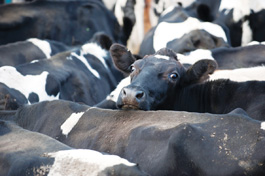home | north bay bohemian index | sonoma, napa, marin county restaurants | preview

BOVINE PERSPIRATION: The USDA weighs whether certified organic animals can be confined or always pastured.
Big Dairy Smackdown
Small ag and Slow Food have a strange new frenemy, the USDA
By Ari LeVaux
Small-ag activists and organic watchdog groups found themselves in terra incognita recently: cheering the USDA. On Feb. 12, the agency published Access to Pasture, a "final rule and request for comments" regarding organic standards for livestock which sees it tightening the definitions of organic meat and dairy. It's been called the most sweeping rewrite of the federal organic standards since their inception in 2002.
The rule closes several loopholes that mega-dairies have used to exploit the organic market with milk from farms that hardly resemble the farms that inspired the now $24.6 billion organic industry.
Access to Pasture mandates that meat and dairy cattle branded organic must graze for a minimum of 120 days on pasture. At least 30 percent of the animals' total annual caloric intake must come from grazing.
While definitive with regard to dairy, the rule leaves one significant question open with regard to meat production: whether beef cows should be exempt from the above grazing requirements during a four-month fattening, or "finish feeding," period, after which they are slaughtered. A 60-day comment period closes April 19.
The new rule is a major blow to certain mega-dairies that for years took advantage of a previous rule that only required organic cows have "access to pasture." The real-life manifestation of this famously ambiguous phrase was often a warehouse door opening to a muddy side yard.
Clarifying "access to pasture" has been under discussion between the National Organic Program and USDA since 1994, and a rule similar to the new rule was first proposed in 2005. It languished in Bush's USDA for a variety of reasons, some of which are currently under investigation. When the draft was opened for public comments, 80,327 were lodged, of which all but 28 respondents favored clarifying the phrase "access to pasture."
Access to Pasture also tightens up several other cracks in the federal definition of organic. It expands and strengthens the language prohibiting antibiotics in organic feed, requires that any edible bedding (like straw and corn cobs) be certified organic, and mandates that pasture be managed as a crop—that is, to produce abundant forage.
Many small-ag types were skeptical of President Obama's appointment of former Iowa governor Tom Vilsack as Secretary of Agriculture. Vilsack's cozy relationship with corporate agribusiness earned him "Governor of the Year" kudos from the Biotechnology Industry Organization.
But one of Secretary Vilsack's first moves was to rip up the plaza in front of the USDA building in Washington and install a certified organic garden. He then recommended that all USDA facilities around the country do the same. Then Vilsack appointed Kathleen Merrigan as deputy administrator, the USDA's No. 2 spot. She's credited with writing the Organic Foods Production Act of 1990, in which Congress gave the USDA authority to oversee the organic industry.
While organic cheerleaders appear to have much to celebrate, some unfinished business will soon tell us more about which direction the USDA is really headed, and how much the public's hands are guiding it.
Public comment just ended on the USDA's December 2009 determination that Monsanto's GE alfalfa seed meets USDA standards. The determination came despite the agency's acknowledgement that the GE alfalfa is likely to cross-contaminate with non-GE alfalfa.
And finally, the burning item of business that Access to Pasture leaves unresolved for another 60 days: "We are requesting comments on the exceptions for finish feeding of ruminant slaughter stock."
As it stands, the USDA exempts beef cattle from the requirement that 30 percent of nutrition come from forage for a period of 120 days prior to slaughter. In practice, this exemption allows organic beef cattle to be confined and fed grain for four months prior to slaughter, a practice known as feedlot finishing.
Access to Pasture notes, "The sentiment among most of the commenters is that there is no place in organic agriculture for the confinement feeding of animals, nor should there be any exception for ruminant slaughter stock."
If that sentiment holds, the organic feedlot exception should end. But if the exception is upheld and "organic" beef is allowed to be "finished" in confinement, that would not only cast doubt on what appears to be a newly inclusive and democratic USDA, it would arguably violate several key aspects of organic livestock production. Confined feeding goes against the organic tenet that animals be allowed to express their true nature, and feeding grain to animals not only produces a different kind of meat that's much less healthy, it's also much more energy-intensive and environmentally destructive.
Perhaps the real discussion shouldn't even be about whether organic beef cows can be confined and grain fed for the last 120 days of their lives. The discussion should be about whether organic cattle should be fed any grain at all.
Send a letter to the editor about this story.
|
|
|
|
|
|
